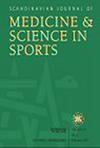Presynaptic Inhibition Does not Mediate Reduced Soleus H‐Reflex Amplitudes During Drop Landings
IF 3.8
2区 医学
Q1 SPORT SCIENCES
引用次数: 0
Abstract
During drop landings, shortly after ground contact, spinal excitability is decreased. This decrease, as measured by soleus H‐reflex, has been presumed, but not proven, to originate from presynaptic inhibition, facilitated by the descending drive from supraspinal centers. Therefore, the aim of this study was to examine presynaptic inhibition during the flight and landing phases of drop landings. Fifteen participants received peripheral nerve stimulations during quiet stance and pre (PRE) and post (POST) ground contact of 40 cm drop landings. Stimulations during drop landings were timed to elicit soleus H‐reflexes 30–0 ms PRE and 30–60 ms POST landings, respectively. Presynaptic inhibition was assessed by conditioning the soleus H‐reflex with femoral nerve stimulations, eliciting H‐reflex heteronymous facilitation (突触前抑制并不介导降落过程中比目鱼H反射振幅的降低
在降落过程中,接触地面后不久,脊髓兴奋性降低。根据比目鱼H反射的测量,这种减少被认为是源于突触前抑制,由棘上中枢的下行驱动促进,但尚未得到证实。因此,本研究的目的是研究在飞行和降落阶段的突触前抑制。15名参与者在安静的站立和40厘米的落地前(pre)和后(post)接触地面时接受周围神经刺激。在降落过程中,刺激时间分别为着陆前30-0 ms和着陆后30-60 ms,以引起比目鱼H -反射。通过股神经刺激来调节比目鱼H反射,引发H反射异位促进(HHF)和腓骨总神经刺激,引发H反射D1抑制(HD1)来评估突触前抑制。条件比目鱼H反射振幅归一化为最大M波(Mmax),并与安静站立、PRE和POST期间的非条件H反射(HTest)进行比较。在下落和安静站立期间测量比目鱼肌、腓肠肌内侧肌、胫骨前肌和股内侧肌以及髋关节、膝关节和踝关节角度的肌电图。HTest POST显著小于PRE (- 8.5% Mmax, p = 0.016)。在安静姿势下观察到促进和抑制作用(HHF‐HTest: +7.8% Mmax, p < 0.001; HD1‐HTest:−9.5%Mmax, p = 0.003),但在PRE或POST期间没有观察到(均p = 1.000)。这两种模式在安静站立时都有效,但在降落时无效,这表明比目鱼H -反射POST的减少不是由于持续的突触前抑制。相反,运动神经元兴奋性的降低可能表明其他潜在的机制。
本文章由计算机程序翻译,如有差异,请以英文原文为准。
求助全文
约1分钟内获得全文
求助全文
来源期刊
CiteScore
7.90
自引率
4.90%
发文量
162
审稿时长
3 months
期刊介绍:
The Scandinavian Journal of Medicine & Science in Sports is a multidisciplinary journal published 12 times per year under the auspices of the Scandinavian Foundation of Medicine and Science in Sports.
It aims to publish high quality and impactful articles in the fields of orthopaedics, rehabilitation and sports medicine, exercise physiology and biochemistry, biomechanics and motor control, health and disease relating to sport, exercise and physical activity, as well as on the social and behavioural aspects of sport and exercise.

 求助内容:
求助内容: 应助结果提醒方式:
应助结果提醒方式:


